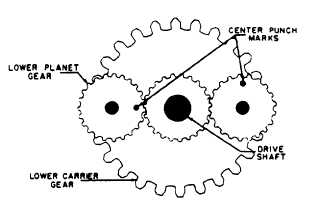|
| |
APPENDIX A
REPAIRS
Clutch type calibrators are of standard and heavy duty
construction. Heavy duty calibrators utilize ball
bearings. Standard calibrators use bronze bushings. It
is not recommended that the case and cover bushings
be replaced unless facilities are available to ream when
cover is assembled to case assuring concentricity. If
worn, the case and cover should be replaced.
DISASSEMBLY
After removing the counter drive gear or coupling,
remove the cover screws. Turn the calibrator upside
down in your hand. This will allow the cover and the
inner mechanism to fall out of the case. Remove the
crank arm and the two sliding blocks.
Next lift out the center disc assembly by grasping the
block pin and turning in a clockwise direction. The cam
disc assembly can then be removed by lifting and
turning in a counter clockwise direction. Remove the six
clutch springs and rollers.
Remove the eccentric arm from the calibrator case by
lifting it off the pin.
All parts should be inspected for wear. The inner
surface of the outer ring and the outer surface of the
cam disc should be free of scratches. Any parts
showing excessive wear should be replaced. See Parts
List 3-B for replacement part numbers.
Reassemble in reverse order of disassembly, with the
following precautions:
1.
When assembling clutch springs and rollers, be
sure all rollers, both inner and outer, are facing
in a counter clock wise direction.
2.
The sliding blocks must not be on the same side
of the shaft. Turn center disc until the blocks
are 1800 apart, before replacing crank arm.
3.
Do not allow the eccentric arm to fall off the pin
when reassembling the case and the inner
mechanism.
All moving parts should be well oiled with S.A.E. 10 oil
or lighter.
“G” OR GREATER TYPE
The "G" type calibrator, Figure 19, is used when ever it
is desirable to operate a meter in either direction.
Normal flow through the meter will increase counter
registration, whereas reverse flow will decrease counter
registration.
The calibrator is so designed that gear ratios can be
varied to permit final corrections of any inaccuracies
due to operating conditions or viscosity of product.
FIG. 19. ‘G’ TYPE CALIBRATOR.
Meter Calibration can be made by removing the
Calibrator access cover located immediately below the
counter. Two small notched shifters and a knurled
rotating knob are thereby exposed (Figure 20).
The right hand shifter is for coarse adjustment of
variations and the left shifter is for fine adjustments.
The knurled knob is provided for manual rotation of
gears to facilitate meshing of gears moved by the
shifters with other gears within the calibrator.
Shifters are released for movement by sliding the
instruction plate to right or left to free the desired shifter.
Pulling the shifters out adds to the level of liquid in the
prover tank by slowing down the counter while pushing
the shifters in lowers the liquid level in the can by
speeding up the counter. Each notch on the coarse
shifter equals 6/10 of one per cent or 138.8 cubic inches
in 100 gallons while each notch on the fine shifter
equals 1/20 of one per cent or 11.5 cubic inches in 100
gallons.
A9-31
|

